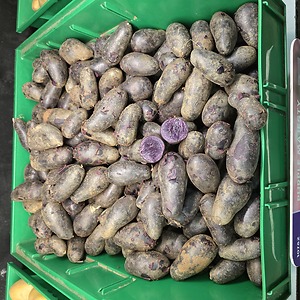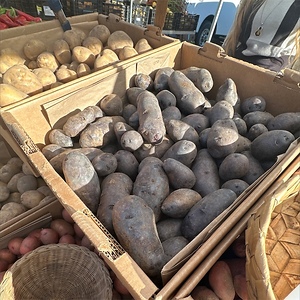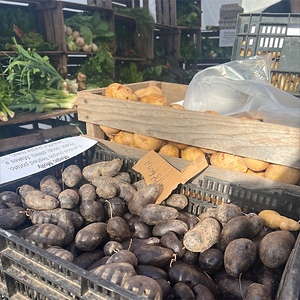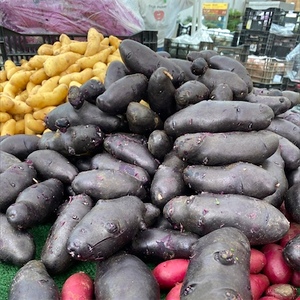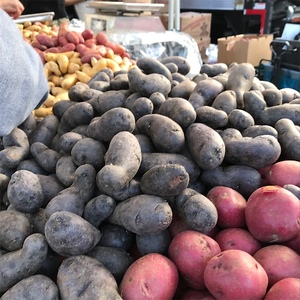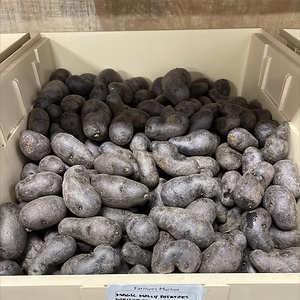

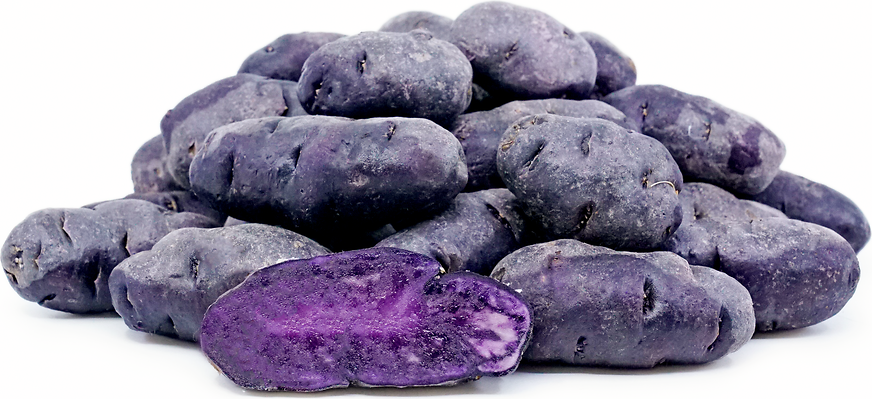
Magic Molly Potatoes
Estimated Inventory, lb : 0
Description/Taste
Magic Molly potatoes are generally small to medium tubers, averaging 5 to 7 centimeters in length, with some potatoes occasionally growing as long as 15 centimeters. The tubers have an elongated, oblong shape and are prone to being misshapen, depending on growing conditions, developing a flattened or bulbous appearance. The skin is semi-smooth, thin, and dark purple, almost black, covered in medium-set eyes and patches of light netting. Underneath the surface, the flesh also bears a rich, dark purple hue, sometimes flecked with white marbling, and when the tubers are sliced, they emit a violet liquid. Magic Molly potatoes have a waxy consistency, containing low starch and high moisture, and develop a soft, fine-grained, and creamy texture when cooked with a sweet, earthy flavor. It is important to note that when the potatoes are harvested small and young, they will be sweeter, while larger, more mature tubers will contain more robust earthy flavors.
Seasons/Availability
Magic Molly potatoes are available in the late fall through winter.
Current Facts
Magic Molly potatoes, botanically classified as Solanum tuberosum, are a highly pigmented, late-season, American variety belonging to the Solanaceae or nightshade family. The saturated, dark purple tubers were discovered growing as a natural mutation in Alaska in the early 21st century and quickly became a favored home garden variety. Magic Molly potatoes were named after the variety’s founder, Bill Campbell’s daughter, and the purple tuber was considered one of Campbell’s greatest achievements in his spud-filled career. Potato enthusiasts favor Magic Molly potatoes for their thin skin, creamy texture, earthy flavor, and dark-purple hue, retaining their vibrant coloring even when cooked. The tubers are also labeled as an all-purpose cultivar that produces good yields and stores well. Despite their small size, Magic Molly potatoes are not categorized as a true fingerling, as the variety can be kept small or grown to larger sizes, and the potatoes are used in a wide variety of culinary applications.
Nutritional Value
Magic Molly potatoes are an excellent source of anthocyanins, pigments found in the flesh containing antioxidant-like properties, and are high in copper, a mineral that helps to strengthen bones and maintain optimal metabolism. The tubers are also a good source of vitamin C to boost the immune system, vitamin B6 to regulate the nervous system, and contain lower amounts of potassium, iron, and fiber.
Applications
Magic Molly potatoes are a versatile tuber best suited for cooked applications, including roasting, baking, sautéing, and boiling. The pigmented potatoes are known for retaining their vibrant purple hues through cooking, especially when roasted and provide a colorful addition to savory dishes. Magic Molly potatoes can be boiled and sliced into salads, mashed as a creamy side dish, or diced and sauteed into a breakfast hash. The potatoes can also be thinly sliced and baked into chips, wedged and roasted as fries, quartered and tossed into soups, stews, and curries, or sliced in half and baked, developing a crisp skin and soft flesh. Beyond savory applications, the tubers are sometimes incorporated into cheesecakes with added sweeteners. Magic Molly potatoes pair well with herbs such as cilantro, parsley, thyme, and rosemary, aromatics such as garlic, onions, shallots, and green onions, Dijon mustard, olives, artichokes, and meats, including poultry, beef, pork, turkey, and fish. Magic Molly potatoes will keep 1 to 2 weeks when stored in a cool, dry, and dark location.
Ethnic/Cultural Info
The United Nations declared 2008 to be the International Year of the Potato, celebrating the spud’s importance in feeding populations worldwide. As part of the celebrations, scientist and discoverer of Magic Molly potatoes, Bill Campbell, hosted an event known as the Palmer Potato Pageant in his resident state of Alaska. Palmer is a small town of approximately 7,000 people, but the event drew over 200 attendees, consisting of breeders, potato enthusiasts, and home gardeners to honor the different potato varieties grown within Alaska. The event also gathered many potato growers who usually are fiercely independent for the first time under one roof, creating peace between competitors for an evening. During the celebration, Campbell recited potato haikus and poetry, created coloring stations for kids to draw potatoes, and even hosted the ugliest potato contest. Growers provided their most misshapen tuber in a lighthearted pageant to see which variety was the most obscure-looking. These misshapen tubers were also used to make potato monsters after the contest by young attendees. Campbell’s event provided common ground between potato enthusiasts, and the event further highlighted the host’s genuine passion for promoting the humble spud. Outside of Alaska, the Palmer Potato Pageant also received nationwide recognition among potato growers and was featured as a segment on the National Public Radio.
Geography/History
Magic Molly potatoes were developed in 2007 by Bill Campbell in Palmer, Alaska. Campbell was a potato breeder and scientist for most of his career, working for Alaska’s Plant Materials Center, and he later partnered with the Alaska Certified Seed Potato Growers to develop new varieties suitable for garden cultivation. Magic Molly potatoes were discovered growing as a natural mutation of the red beauty potato and were selected for their pigmented flesh and favorable culinary attributes. Today Magic Molly potatoes are a popular variety sold through online seed catalogs and are also grown by select potato growers across the United States and Canada.
Recipe Ideas
Recipes that include Magic Molly Potatoes. One







